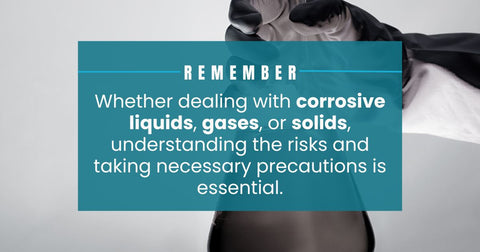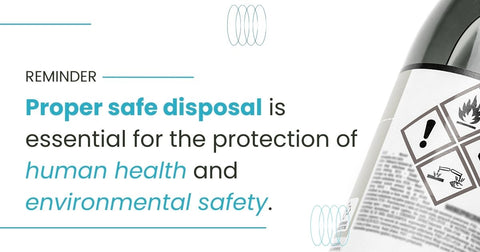If you’re working in a lab, you’ll come across corrosive chemicals at some point. Knowing how to handle them properly, the protocols needed, and the equipment necessary for these are paramount. But before we dive further, let’s discuss first the common type of corrosive chemicals you’d come across often.
Common Corrosive Chemicals and Lab hazards
Corrosive chemicals when in contact with your skin will irritate your skin and may cause permanent damage. While this is not an extensive list, it’s essential for any lab personnel, especially new ones, to do their research before handling any chemicals.
Corrosive Liquids
These liquids can cause severe damage to the skin and eyes upon direct contact:
- Sulfuric Acid (H₂SO₄): A strong mineral acid used in various industrial processes, battery production, and laboratory work. It can cause severe burns upon contact with skin or eyes.
- Hydrochloric Acid (HCl): Another strong mineral acid commonly used for cleaning, pickling, and pH adjustment. It emits pungent fumes and can corrode metals and tissues.
- Nitric Acid (HNO₃): Used in chemical synthesis, etching, and explosives production. It is highly reactive and can cause burns and respiratory irritation.
Corrosive Gasses and Vapors
These gasses are harmful and may lead to sever side effects if inhaled:
- Ammonia (NH₃): A colorless gas with a strong, pungent odor. It is corrosive to the respiratory tract and eyes.
- Chlorine (Cl₂): A greenish-yellow gas used in water treatment and as a disinfectant. It can cause severe respiratory distress and skin burns.
- Hydrogen Fluoride (HF): A highly corrosive gas used in glass etching and industrial processes. It penetrates tissues deeply and can lead to systemic toxicity.
Corrosive Solids
Much like corrosive liquids, these common corrosive solids can cause irritations if in direct skin contact:
- Potassium Hydroxide (KOH): A strong base in solid form. It is used in soap production and as a reagent. Skin contact can cause burns.
- Calcium Oxide (CaO): Also known as quicklime, it reacts vigorously with water to form calcium hydroxide (slaked lime). It can cause skin and eye burns.
- Sodium Hydroxide (NaOH): Commonly known as lye, it is used in cleaning products and chemical manufacturing. It is highly caustic and can cause severe tissue damage.
Handling Techniques and Best Practices
When working with corrosive chemicals, it’s crucial to follow proper handling techniques and best practices to ensure safety. Whether dealing with corrosive liquids, gasses, or solids, understanding the risks and taking necessary precautions is essential. Let’s explore these techniques in detail.

Corrosive Liquids
Always wear appropriate PPE, including chemical-resistant gloves, eye protection, and chemical-resistant clothing. Gloves and clothing should be made of materials that prevent corrosives from contacting the skin. Eye protection options include safety glasses or goggles with side shields.
When diluting concentrated acids (e.g., sulfuric acid, hydrochloric acid), slowly add acid to water (specifically, add the more concentrated acid to the dilute acid). Never add water to acid directly, as it can cause splattering and heat generation.
Storage and Handling for Corrosive Liquids
- Store corrosive liquids separately from other materials.
- Use chemical-resistant containers and ensure they are properly sealed to prevent leaks.
- Transport chemicals using drum cradles or container caddies to minimise contact.
- Address damaged or leaking containers promptly to prevent spills.
Corrosive Gasses and Vapors
Start by wearing gloves and eye protection. This will shield your skin and eyes from potential harm. Following this, ensure you’re working within a chemical fume hood. This step is vital as it significantly reduces the risk of inhalation exposure. By adhering to these safety measures, you can effectively minimise inhaling these hazards.
Storage and Handling Corrosive Gases and Vapors
- Store corrosive gas cylinders separately from incompatible materials.
- Close regulators and valves when not in use and flush with dry air or nitrogen after use.
Corrosive Solids:
Wear gloves and as usual, eye protection. Ensure that the gloves are composed of butyl rubber or other materials known for their resistance to corrosion. If there’s a possibility of dust generation, exercise extra caution. In such scenarios, it’s advisable to conduct your work within a fume hood. This way, you can maintain a safe environment while handling corrosive solids.
Storage and Handling for Corrosive Solids
- Avoid pipetting these liquids by mouth, as this is a common route to accidental poisoning!
- Instead, opt for safer alternatives like pipette bulbs or aspirators.
- Use scoops or shovels when handling or transferring. Ensure these tools are made of corrosion-resistant materials to prevent any unwanted reactions.
Remember to consult the Safety Data Sheet (SDS) for specific guidance on handling each chemical. Safety is paramount when dealing with these substances!
Best Laboratory Safety Equipment for Corrosive Chemicals
When handling caustic chemicals, it’s essential to equip your laboratory with the right safety equipment. Here are additional recommendations for safe storage and handling:
Chemical Storage Cabinets and Bottles
Approved safety cabinets are crucial for storing chemicals safely. They also prevent accidental spills and protect against fire hazards. When shopping for a Chemical Storage Cabinet or Bottles, make sure they’re made of materials that withstand corrosive effects like High-Density Polyethylene (HDPE), Epoxy-Coated Steel, or Fiberglass-Reinforced Plastic.
Personal Protective Equipment (PPE)
When working with concentrated corrosive solutions, prioritising safety measures is crucial. Instead of relying solely on safety glasses, opt for splash goggles to shield your eyes effectively. For enhanced protection, consider pairing the splash goggles with a face shield.
Additionally, Chemical-Resistant Gloves made of materials like butyl rubber should be worn to prevent direct skin contact. When handling corrosive liquids, an additional layer of defense in a Rubber Apron may be necessary.
Furthermore, using a Chemical Fume Hood is essential as it minimises exposure to corrosive vapours and gasses. Always handle corrosive substances inside the fume hood to ensure safety. Lastly, when mixing concentrated acids with water, follow this critical safety tip: add acid slowly to water (specifically, add the more concentrated acid to the dilute acid) to prevent splattering and potential harm. Vigilance and adherence to safety protocols are paramount in handling corrosive substances.
Safety Data Sheets (SDS)
The SDS contains essential information about the chemical's hazards and compatibility with other substances. It also includes first aid measures, recommended protective equipment, and appropriate emergency response procedures. Whether handling corrosive acids, flammable solvents, or toxic compounds, the SDS is your go-to checklist to mitigate risks effectively.
How to Dispose Corrosive Chemicals
Proper safe disposal is essential for the protection of human health and environmental safety. Here are several standard procedures for corrosive chemical disposal:

Neutralise the chemicals first
For disposing of a minimal amount of corrosive liquid, neutralisation is a viable method. Introduce a mild base (e.g., baking soda or sodium bicarbonate) to acid solutions (such as sulfuric acid or hydrochloric acid) to neutralise them. This reaction yields water and salt, which pose less risk. It's important to adhere to safety measures and wear protective equipment during this process.
Dilute them with water
When dealing with larger volumes of corrosive liquids, consider dilution. Combine the corrosive liquid with a significant amount of water to lower its concentration. Follow local regulations for the disposal of the diluted mixture. Exercise caution to avoid generating excessive heat during the dilution process.
Reach out to your local hazardous waste disposal centre
Reach out to your local hazardous waste disposal centre or municipal authority for information on collection schedules or drop-off sites. They will provide instructions on how to properly prepare and label corrosive chemicals for safe transportation.
Additionally, some chemicals necessitate the expertise of professional disposal services. These entities are equipped to manage and dispose of hazardous waste safely. Seek out a certified waste management company for help.
Store them in proper containers
Choose suitable containers that are resistant to the corrosive nature of the chemical, such as glass or certain plastics. Metal containers should only be used if they are designed for storing corrosive materials.
Label them before disposal
Ensure that containers are clearly marked with the name of the chemical, hazard symbols, and other necessary information to inform handlers of the waste's nature.




